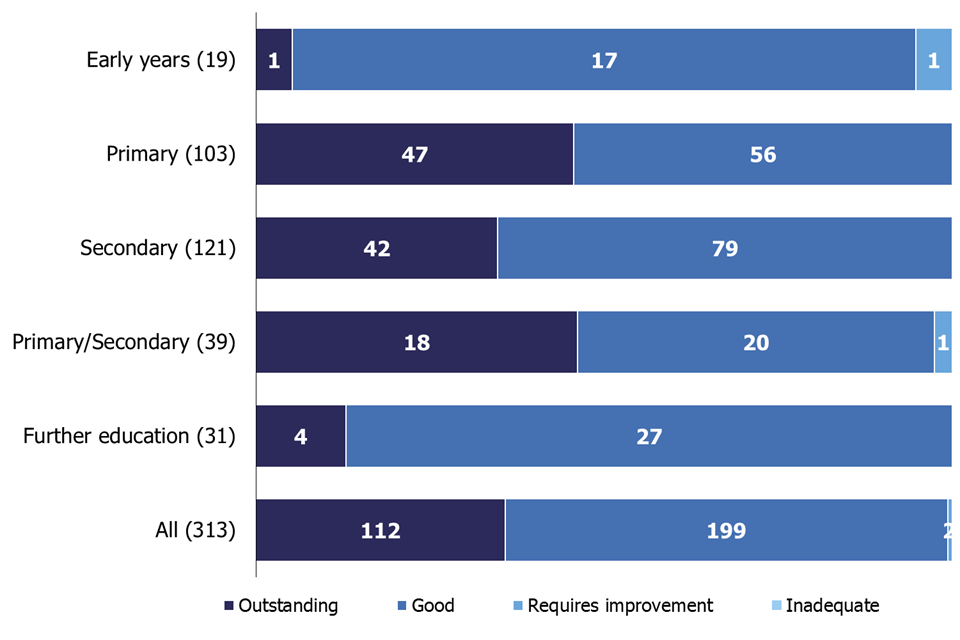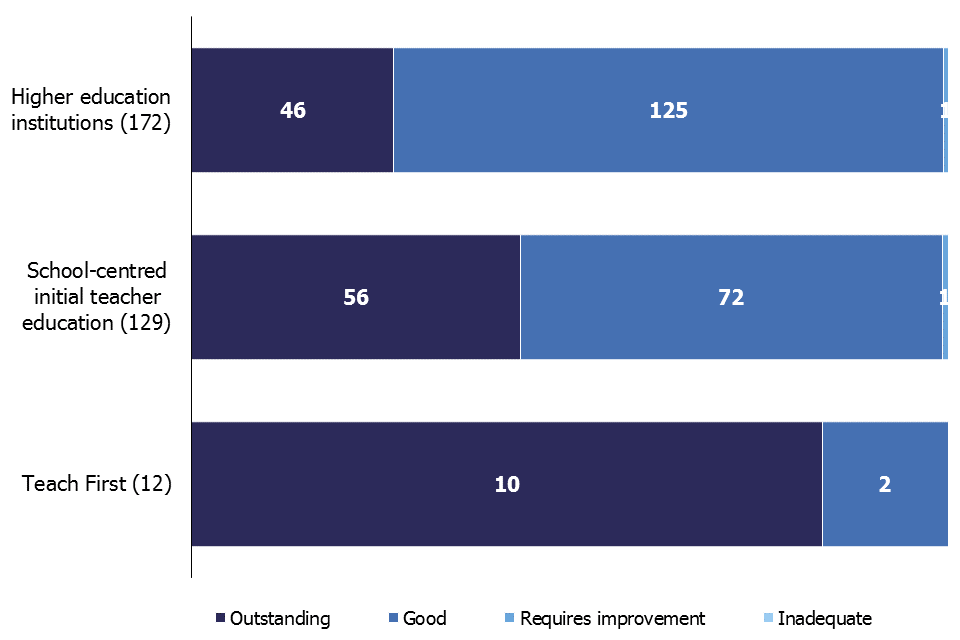Initial teacher education inspection (ITE) outcomes as at 30 June 2018
Updated 21 September 2020
This release contains:
- data for inspections completed in the 2017 to 2018 academic year
- most recent inspection outcomes as at 30 June 2018
- additional analysis of age phase partnerships judged to require improvement or to be inadequate since September 2012
Almost all ITE age phase partnerships continue to be good or outstanding.
99% of age phase partnerships are good or outstanding. 36% of age phase partnerships were judged outstanding at their most recent inspection.
Since 2012, 30 ITE age phase partnerships have been judged to be less than good.
Since September 2012, 30 ITE age phase partnerships have been judged less than good. Of these, around a third have since closed.
A higher proportion of school-centred age phase partnerships are outstanding compared to higher education age phase partnerships.
43% of school-centred initial teacher education age phase partnerships are outstanding compared to 27% of higher education age phase partnerships.
Figure 1: Most recent overall effectiveness as at 30 June 2018

1. Main findings
Teaching in state-funded schools (under local authority control) in England requires specific qualifications, on top of the subject knowledge experience or degree one might have. For example teaching in state-funded primary or secondary schools requires qualified teacher status. Early Years Teacher Status is available for those wishing to specialise in working with babies and children from birth to 5. Initial teacher education/training is the training that enables a prospective teacher to gain the required professional status or qualification in ITE in further education (FE).
2. Outcomes of age phase partnerships at their most recent inspection
Three hundred and eleven of the 313 ITE age phase partnerships were judged to be good or outstanding at their most recent inspection. The remaining 2 were judged to require improvement (see figure 1). At 99% good or outstanding, the proportion of good or outstanding age phase partnerships is the same as it was at the end of June 2016 and June 2017.
However the proportion of outstanding age phase partnerships has increased by 2 percentage points to 36% since the end of June 2017 and the proportion of good age phase partnerships has decreased by 2 percentage points to 64%.
With just one outstanding age phase partnership out of 19, early years has the lowest proportion of outstanding age phase partnerships. Primary and primary/secondary partnerships have the highest proportion of outstanding partnerships where just under half of all partnerships are outstanding.
The 2 age phase partnerships that require improvement are early years initial teacher training (ITT) at Oxford Brookes University and primary/secondary training at Peninsula Teacher Training Cornwall school-centred initial teacher training (SCITT). Oxford Brookes is no longer offering early years ITT and Peninsula SCITT closed at the end of the 2017 to 2018 academic year. Therefore neither of these age phase partnerships were re-inspected this year.
3. Age phase partnerships without inspection outcomes
Three hundred and thirteen of the 366 open initial teacher education age phase partnerships have a current inspection judgement. This means 14% have no current inspection judgement. The majority of these (49) are SCITTs, 2 are higher education institutions, one is a Teach First partnership and one is employment based initial teacher training (EBITT). See Table 1 for details.
The majority of these age phase partnerships with no current inspection judgement have either; had their stage one inspection (see notes section for details of inspection stages) in summer 2018, or are EBITTs that were inspected within the current inspection framework and subsequently converted into SCITTs. The inspection judgement of an EBITT partnership that has converted to a SCITT is not included in our reporting data. The remainder of these age phase partnerships have not yet been open long enough to be inspected.
Table 1: Number of open initial teacher education age phase partnerships as at 30 June 2018
| Type of provision | Number (inspected) | Proportion (inspected) | Number (not inspected) | Proportion (not inspected) | Total |
|---|---|---|---|---|---|
| Higher education institutions | 172 | 99 | 2 | 1 | 174 |
| School-centred initial teacher education | 129 | 72 | 49 | 28 | 178 |
| Teach First | 12 | 92 | 1 | 8 | 13 |
| Employment based initial teacher education | 0 | 0 | 1 | 100 | 1 |
| Total | 313 | 86 | 53 | 14 | 366 |
4. Outcomes by type of age phase partnership
The inspection outcomes for the most recent ITE inspections are very positive for all types of age phase partnerships. Ninety nine percent of both SCITT age phase partnerships and higher education institution age phase partnerships (HEIs) are good or outstanding. Twelve of the thirteen Teach First age phase partnerships have been inspected. Ten were judged to be outstanding and 2 judged to be good. A larger proportion of SCITT than HEI age phase partnerships are outstanding (43% and 27%, respectively). HEI partnerships are much larger institutions, teaching far more trainees, and usually offering multiple phases (for instance early years ITT and further education).
Figure 2: Most recent overall effectiveness as at 30 June 2018, by partnership type

One hundred SCITTs are part of a multi-academy trust (MAT). Of these, 65 have been inspected, covering 68 age phase partnerships. Of these 68 age phase partnerships, 31 were judged to be outstanding, 36 were judged to be good and one was judged to require improvement. So far the outcomes for inspections of SCITTs in MATs are fairly similar to those for SCITTs not in MATs. A fuller picture of the quality of SCITTs in MATs will be possible when the remaining partnerships have been inspected.
5. Less than good ITE provision
Since September 2012, 30 ITE age phase partnerships have been judged to be less than good. Two were judged inadequate and 28 required improvement.
The 30 age phase partnerships judged less than good covered the following age phases:
- 10 primary
- 6 early years
- 5 secondary
- 4 combined primary/secondary
- 3 ITE in FE
- 2 employment based routes (EBR)
Sixteen age phase partnerships improved to good at their first re-inspection following a less than good judgement. One partnership improved to good at a second re-inspection. Two partnerships did not improve after re-inspection and subsequently closed.
The remaining 11 age phase partnerships closed before re-inspection.
Where ‘provision is repeatedly of requires improvement or lower quality’ (see Initial Teacher Training (ITT) accreditation withdrawal process, NCTL, 2014) the Department for Education will often withdraw trainee allocations until the provision has been judged to be good or outstanding. As a result, some partnerships close all or part of their provision when judged to be less than good.
This policy is also one of the reasons why inspection outcomes for all open partnerships are so high: weaker age phase partnerships often close, and closed partnerships are not included in the outcomes for all open partnerships at their most recent inspection.
6. Inspections between 1 September 2017 and 31 August 2018
Ofsted conducted 55 inspections of 52 different partnerships in the 2017 to 2018 academic year. Following a less than good judgement, 3 age phase partnerships received a re-inspection and were therefore inspected twice within the reporting period.
The 55 inspections resulted in 70 sets of inspection outcomes because most partnerships have more than one age phase partnership. Of these, 26 were outstanding, 39 were good and 5 were judged to require improvement.
Figure 3 combines the outcomes of each type of inspection this year, and includes an age phase partnership more than once if a partnership was inspected more than once during the year.
Figure 3: Overall effectiveness judgements from inspections concluded between 1 September 2017 and 31 August 2018

7. Revisions to previous release
There are no revisions to the previous release.
8. Notes
Initial teacher education inspections take place over 2 stages:
-
Stage one occurs in the summer term and allows inspectors to observe trainees at the end of their training. No inspection judgements are formed during this stage.
-
Stage two takes place in the following autumn and focuses on observing newly qualified teachers or former trainees (qualified teacher status is only awarded for primary and secondary routes, not for ITE in FE or Early Years). Outcomes of inspections are only finalised after the second stage.
This release covers the age partnerships which had the second stage of their inspection in autumn 2017.
Each partnership of initial teacher education can offer training for up to 4 different age ranges. These are called age phase partnerships and cover:
- early years ITT
- primary
- secondary
- further education
Any age phase partnership found to be less than good will usually receive a single stage follow-up inspection within the same academic year. The outcomes for these inspections are also included in this release.
In most inspections a separate set of inspection judgements is awarded to each age phase partnership. Ofsted may produce a combined judgement for both primary and secondary phases if a provider only has a small number of trainees.
Where ‘provision is repeatedly of requires improvement or lower quality’, the Department for Education will often withdraw trainee allocations until the age phase partnership has been judged to be good or outstanding. As a result, some partnerships close all or part of their provision when judged to be less than good. This is one reason why inspection outcomes are so high: weaker partnerships often close, and closed partnerships are not included in the statistics on the outcomes for all open partnerships at their most recent inspection.
9. Glossary
This can be found within the methodology and quality report.
If you have any comments or feedback on this publication, please contact Louise Butler on 03000 131 457 or [email protected].
10. Acknowledgements
Thanks to the following for their contribution to this statistical release: Oli Bayntun, James Jordan, Fiona Lewis and Issa Mohamed.

